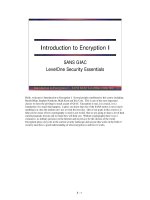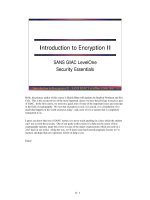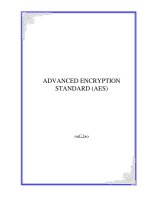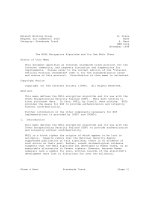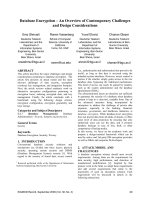Encryption
Bạn đang xem bản rút gọn của tài liệu. Xem và tải ngay bản đầy đủ của tài liệu tại đây (341.48 KB, 19 trang )
Encryption
Overview
For hundreds of years people have used codes and ciphers to protect important information from
the view of others. Computers store, manipulate, and transmit information swiftly and accurately.
Codes and ciphers that were difficult and time consuming to perform by hand now take only−
milliseconds on a computer, so encryption has found a new home in computer operating systems
and networks.
Firewalls use codes and ciphers for two vitally important purposes:
• To prove the identity of a user (authentication)
• To hide the contents of a data stream (encryption)
This chapter will first examine what encryption is and how it has developed from a tool for spies and
diplomats to become an integral part of modern communications. Next, you'll see how computer
networks use encryption to secure your files, keep out unauthorized users, provide a secure
channel for communications, and identify trusted computers or users. Finally, you'll be introduced to
the several kinds of encryption and the strengths of and uses for each. In addition, you'll be given a
glimpse of how a network intruder might attempt to circumvent encryption measures on your
network.
This chapter covers encryption in general. Encryption as it is used in firewalls specifically for Virtual
Private Networking is covered in Chapter 9.
How to Keep a Secret
The primary purpose of encryption is to keep secrets. Encryption was first used to protect messages
so that only the person knowing the "trick" to decoding the message (or the key in the jargon of
cryptographers) could read the message. History is full of clever codes and ciphers used by kings
and princes, spies, generals, business people, and inventors. As you read through this chapter,
you'll see examples of historical codes and ciphers, and learn how the concepts illustrated by those
examples are used in computers today.
A cipher protects a message by rearranging it or performing modifications to the encoding, rather
than the meaning, of the message. A code is an agreed upon way of keeping a secret between two−
or more individuals. A key is a bit of information that is required to decrypt a message, usually in the
form of a value that is used with a cipher to encrypt a message. The key must be kept secret in
order for the message to remain private.
Ciphers
One example of a cipher is used by children around the world: Pig Latin (no offense is intended
towards pigs or aficionados of Latin). The secret is simple—the first consonant is moved to the end
of the word and the "ay" sound is appended to it. If the word begins with a vowel, simply append
"ay." Thus: "Isthay isay anay iphercay orfay implesay essagesmay."
Many dialects of the Pig Latin cipher exist; you could use the keys "oi" or "ah" instead. What makes
this cipher different from a code like, say, the backwards day code (wherein words take on their
98
opposite meanings on the agreed upon "backwards day") is that you can encode any message in
pig Latin. This ability to encode any message (or plaintext, as unencrypted messages are called),
regardless of subject, is a common feature of all ciphers. This is not a feature of codebooks.
Codebooks operate by obscuring the meaning of words in messages and are limited to the words in
the book, whereas ciphers obscure the words being used regardless of what the words actually are.
Backwards day is a code; Pig Latin is a cipher.
A cipher almost as simple as Pig Latin that is being used on the Internet and on computer bulletin
boards around the world today is the Rot(13) cipher. If you've seen an e mail or newsgroup−
message that looks like a jumble of random letters and has <rot13> at the top, then you have seen
a message using this cipher. The trick to decoding it (the trick is called the algorithm in the jargon of
cryptographers) is to rotate each letter through the alphabet 13 places. For example, A would be
replaced with N, B would be replaced with O, W would be replaced with J, and M would be replaced
with Z. Vg'f abg n irel pbzcyvpngrq pvcure. This is a simple substitution cipher, so called because
each letter of the alphabet is replaced with a substitute letter. The key is to know which letters are
replaced with which other letters—in this case, the letter 13 letters away from it (it doesn't matter if
you rotate backward or forward, because there are 26 letters in the English alphabet).
The Rot(n) cipher is a generalization of Rot(13), in which you can select the number (n) of rotation,
rather than just automatically using 13. Rot(n) has a key input, like DES and other private key
ciphers that you can specify to use for encryption and decryption. If you want to use Rot(n) to
encode or decode a Rot(13) text, you would use 13 as the key. Figure 5.1 shows how the Rot(n)
substitution cipher works.
Figure 5.1: In the Rot(n) substitution cipher, the plaintext is rotated several characters for encryption
into ciphertext, and then rotated several characters back into plaintext for decryption.
Rot(n), like Pig Latin and backwards day, is not very hard to figure out. Any message encoded with
a simple substitution cipher (if the message is long enough—25 characters is enough for most
99
messages) can be decoded simply by counting the frequency of each letter. The letter E, for
example, is the most common English letter and will probably be the one at the top of the frequency
list. Common two and three letter combinations of letters are also clues to the hidden identity of− −
substituted letters.
Another kind of cipher is the transposition cipher. Instead of replacing the letters in a message, this
kind of cipher rearranges them. Imagine writing the letters of a message in the squares of a piece of
graph paper. You would then copy the message to another sheet of paper, but instead of copying
the letters from left to right you would do so from top to bottom. To decipher the message, you
would put the letters back on graph paper from top to bottom and then read them from right to left,
as usual.
A weakness of ciphers is that if someone knows the cipher you are using and the key you have
chosen (say you are using the cipher PigLatin97 with the secret key "chu"), then everything you
send or have sent with that cipher and key can be read by that person. This makes it very important
to choose a cipher that is difficult to crack and a key that is difficult to guess.
Keeping Secrets Automatically
Encryption and decryption take a long time to perform by hand, and when your computing tools are
limited to a pencil and paper (and, of course, the substitution alphabets or codebook) you can only
use the simplest of ciphers. However, for hundreds of years the manual process was the only way,
until the advent of the Industrial Revolution and the invention of calculating machines.
The various national governments of the 1920s developed rotor machines to automate the
encryption and decryption process of cryptographic substitution. The ability to send secure and
lengthy messages from the headquarters of the various armed forces to remote locations over a
medium that anyone could eavesdrop on (the newly invented radio) proved to be a crucial aspect of
modern warfare. Secure communications often meant victory, and broken codes often meant
defeat. The most popular encryption machines had rotors and were primarily mechanical.
Each machine contained a number of rotors, and each rotor was wired to replace one letter with
another letter. The rotors would rotate at different rates, so a machine with rotors that had 26
positions (one for each letter of the English alphabet) would have a period of 26 raised to the
number of rotors. This means that a rotor machine with three rotors would encode the same letter
with the same encrypted value every 20,000 or so letters of the message. The Enigma machine
used by the Germans in the late '30s was the most famous rotor machine of the time and was
fiendishly difficult for British cryptanalysts to crack.
Keeping Secrets Electronically
The development of electronics and computers gave code makers and code breakers a whole new
arsenal to work with. They were able at last to develop ciphers that were much too complex to
perform by hand. They could also program computers to automatically try many different
combinations of keys and ciphers much more quickly than human beings were able to. Many
ciphers were developed in secret, and only governments or large corporations had the computing
power necessary to use or break the codes.
One algorithm that was developed in secret but then released for use by the public as well as the
government (but only for "Unclassified but Sensitive" information) is the Data Encryption Standard,
or DES. It is a symmetric algorithm, which means the same key is used for encryption and
decryption, and uses a 56 bit key. DES is widely used in commercial software and in−
100
communication devices that support encryption. There is lingering suspicion, however, that the DES
algorithm might contain a weakness that could allow the National Security Agency (NSA)—which
has a vested interest in maintaining its ability to decrypt communications and which cooperated in
the development of DES—to more easily break messages encrypted with DES.
RSA (which was named after its inventors) is an algorithm that was not developed by a government
agency. Its creators—Rivest, Shamir, and Adleman—exploited the computationally difficult problem
of factoring prime numbers to develop a nonsymmetric, or public key algorithm, which can be used
for both encryption and digital signatures. RSA has since become a very popular alternative to DES.
RSA is used by a number of software companies that produce products that must negotiate secure
connections over the insecure Internet (such as web browsers), including Microsoft, Compaq, Sun,
Netscape, and IBM.
In the mid '90s, the NSA and the Executive branch of the U.S. Government developed a new
encryption technology and attempted to convince the rest of the government as well as the private
industry to use it. First called "Clipper" and then "Capstone," the encryption scheme uses hardware
that embodies a classified algorithm (called the "Skipjack" algorithm). The algorithm uses a secret
key in combination with an escrow key or keys. The escrow keys are meant to be given to a pair of
government or other key escrow agencies. Authorized law enforcement officials can then obtain the
keys to the hardware device and decrypt any messages encoded by that device. The ostensible
purpose is to make further digitally encrypted communications devices wiretappable. The Clipper
and Capstone efforts have been abandoned because of a complete lack of support from the private
sector because they are viewed as a threat to privacy.
The ciphers described here are not the only ones available for use in computers and networks
today—other governments (such as the former USSR) were just as active as the United States in
developing codes and ciphers, and many private individuals (especially in the last decade) have
made contributions to the field of cryptography. GOST was developed in the former USSR, FEAL
was developed by NTT Japan, LOKI was developed in Australia, and IDEA was developed in
Europe. Most of these ciphers use patented algorithms that must be licensed for commercial use,
but there are some (such as Blowfish and Twofish, which are described later in this chapter in the
section on symmetric functions) that are not. Each cipher has strengths and weaknesses, some of
which will be explored later in this chapter.
A recent addition to the ranks of encryption algorithms is the winner of a National Institute of
Standards and Technology contest for a new Advanced Encryption Standard cipher to replace DES.
The Rijndael cipher won the contest and can be expected to start showing up in all sorts of security
products. This cipher was developed and selected using an open process, unlike DES and
Capstone, which may eliminate some people's concerns about backdoors and hidden weaknesses
in government supported algorithms. The truly paranoid will most likely still avoid it merely because−
it has been blessed by the government.
Note All of the ciphers described in this section have the same weakness: If you know the cipher
being used to encode a message but not the key, there are a number of attacks you can use
to attempt to decode the message, including the "brute force" method of trying all of the
possible keys.
The purpose of ciphers, after all, is to hide information. Hiding information would not be a useful
activity (especially for wartime governments that have other pressing areas to spend time and
money on) if no one were interested in the information being hidden. The converse of hiding
information is attempting to discover what is hidden, and advances in breaking codes (or
deciphering codes without the keys) have progressed hand in hand with developments in creating− −
101
codes. The practice of attempting to break codes is called cryptanalysis, and the people who break
codes are called cryptanalysts.
Cryptanalysts have developed other key discovery methods beyond brute force cryptanalysis.−
Differential and linear cryptanalysis are two examples of the esoteric art of breaking codes; they are
complex mathematical analyses that would take a book each to explain. Some ciphers are more
vulnerable to these two methods of cryptanalysis than other ciphers. Some ciphers use a longer key
than others (a longer key contains more bits) and therefore require more time or compute power to
go through all of the possible keys. Some ciphers can accept a variable number of bits in the key
(you can choose how strong you want the encryption to be). Once the key is discovered, however,
all of the messages encrypted using that cipher with that key are compromised.
The Almost Perfect Cipher
There is one encryption cipher—the one−time pad—which cannot be compromised without
possession of the key, even with all the time left in the universe and all the compute power that is
theoretically possible. It is not simply improbable that the key would be discovered or the message
retrieved by using brute force; it is impossible. Unfortunately, the requirements of the cipher make it
impractical for use in anything but certain kinds of low bandwidth communications.−
A one time pad uses a key that is exactly the same length as the message being encoded. The key−
must be completely random (anything less than random leaves your message open to certain kinds
of cryptographic analysis), and no portion of it can be re used without compromising the security of−
your message. Each letter (or byte) of your message is combined mathematically with an
equal sized portion of the key (often by the XOR mathematical function or addition with modulus−
mathematical function), which results in the ciphertext and uses up the key.
The reason that the one time pad is so secure is that, from the ciphertext being decoded, any−
resulting plaintext (of the same length) and associated key is equally likely. For example,
"henryjtillman" encoded with the one time pad key "lfwpxzgwpoieq" results in the ciphertext−
"tkkhsjafbavfe." While the ciphertext decoded with the correct key produces the original message,
the ciphertext can also be decoded using the possible key "swgpnmquypciq" resulting in the
message "andrewjackson," or using the key "gbywrvwcmlkwz" resulting in the message
"milkandcookie." The attacker has no way of knowing which key and resulting plaintext is correct.
The problem with the one time pad is that it requires a key as big as the message being sent, and−
both the sender and the receiver must have the same key. If you must encrypt a 10Mbps Ethernet
link you could use up a CD ROM worth of key data in just 10 minutes!−
Note Clearly, the one time pad is best used in cases where communication is infrequent or uses−
very little bandwidth, such as e mail messages that must have the most secure encryption−
possible.
Encryption in Your Network
The previous section took a look at how cryptography developed and how it works in a cursory
manner. The next section, "A Conspiracy of Cryptographers," will examine the world of
cryptography in greater detail, explore the advantages and disadvantages of specific algorithms, as
well as give you a glimpse of how they can be broken. This section focuses on how you can use
encryption in your network.
102
After all, what good is a secret decoder wheel if you have no secrets to keep? You can use
encryption to protect the following types of network data:
• Private communications
• Secure file storage
• User or computer authentication
• Secure password exchange
You should encrypt any communications containing sensitive or proprietary information that go over
an insecure medium such as radio, a telephone network, or the Internet. Use file system encryption
to protect sensitive data when operating system features are not effective (when the hard drive has
been removed or the operating system has been replaced).
Private Communications
The most common use for encryption with computers is to protect communications between
computer users and between communications devices. This use of encryption is an extension of the
role codes and ciphers have played throughout history. The only difference is that instead of a
human being laboriously converting messages to and from an encoded form, the computer does all
the hard work.
E−Mail
Many e mail packages include the facility to encrypt an e mail message before sending it; even− −
those programs that do not can include encrypted text that comes from a separate encryption
program such as Pretty Good Privacy (PGP). When you receive an encrypted e mail message you−
can have the e mail package decrypt it for you (if your e mail supports encryption—basic LAN− −
e mail products such as Microsoft Exchange and cc:Mail often don't, but advanced packages such−
as Microsoft Exchange Server do) or you can use an external program to decrypt the message.
In order to encrypt or decrypt a message you must have the key to the message. You'll usually use
the same key for messages to the same person, so if you regularly exchange encrypted mail with a
lot of people, you'll have a lot of keys to keep track of. Your e mail package or your encryption−
package can make keeping track of keys easier by storing your keys in key rings (files on your disk
drive that keep track of your keys for you). The key rings are, of course, encrypted and protected by
a key as well. The benefit of this is that you only have to remember one key.
Communications Links
Encryption can protect the communication between network devices as well as between computer
users. Any time two network devices are communicating over an insecure medium (that is a
medium that an intruder can listen in on), you should consider encrypting the communication. For
example, you might encrypt the data transferred over a microwave link between buildings if
sensitive data flows over the link.
Encryption can be expensive, however, either in terms of the processing power required to encrypt
or decrypt data, or in terms of the cost of specialized hardware to do the same thing. The more data
there is to encrypt (the greater the bandwidth of the encrypted link), the more processing power is
required. So, while any modern personal computer can encrypt a 56Kbps modem link without
slowing down the user's applications all that much, encrypting a 100Mbps fast Ethernet link will tax
even the most powerful RISC and Pentium processors.
103
Dedicated encryption hardware also costs much more than regular unencrypted communications
devices like Ethernet adapters and modems. For these reasons you probably would only encrypt
those portions of your network that are exposed in a way that they are accessible to an
eavesdropper.
Secure File Storage
Encryption isn't just for communication. It can also be used to protect data in storage, such as data
on a hard drive. All Unix implementations, as well as Windows NT, have many sophisticated
security features. You may have configured your OS to allow only authorized users to access files
while the operating system is running, but when you turn your computer off, all those security
features go away and your data is left defenseless. An intruder could load another operating system
on the computer, or even remove the hard drive and place it in another computer that does not
respect the security settings of the original computer.
Encryption Utilities
You can use encryption software to encrypt specific files that you want to protect, and then decrypt
them when you need to access them. The encryption and decryption process can be cumbersome,
however, and you may end up having to remember a lot of encryption keys. Using encryption in this
m a n n e r c a n a l s o e a s i l y c a u s e y o u t o l e a v e b e h i n d f i l e s t h a t c o n t a i n s e n s i t i v e
information—temporary files or files that are erased but still present on the hard drive after you
delete the original encrypted document. This is obviously not what you want.
Encrypted File Systems
A better approach to security is to have the operating system encrypt and decrypt the files for you.
You can get encrypted file systems for Windows NT, and Windows 2000 ships with a disk
encryption service. Most versions of Unix will encrypt all the files on your hard drive, even temporary
ones created by the applications you use.
You must supply the cryptographic key when you start your computer, but otherwise you can treat
the files on your hard drive as regular, unencrypted files. This doesn't protect your files from being
accessed while the operating system is running—that is what the operating system security features
are for—but it does keep the data safe, even if someone steals the hard drive.
User or Computer Authentication
In addition to keeping secrets (either stored or transmitted), encryption can be used for almost the
opposite purpose—to verify identities. It's used to authenticate users logging on to computers, it's
used to ensure that software you download from the Internet comes from a reputable source, and
it's used to ensure that the person who sends a message is really who they say they are.
Logon Authentication
You may not know it, but your operating system already uses encryption. When you log on to a
Microsoft operating system such as Windows 95 or Windows NT, the operating system does not
compare your password to a stored password. Instead, it encrypts your password using a one way−
cryptographic function, and then compares the result to a stored result. Other operating systems
such as Unix and OS/2 work the same way.
104

